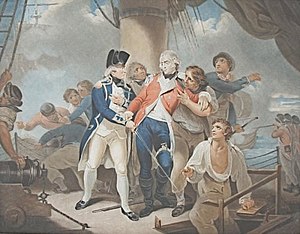 Captain Henry Trollope with the mortally wounded Marine Captain Henry Ludlow Strangeways on the deck of HMS Glatton
| |
| History | |
|---|---|
| Name | Glatton |
| Owner | Richard Neave[1] |
| Builder | Wells & Co. of Blackwell |
| Launched | 29 November 1792 |
| Fate | Sold to the Royal Navy in 1795 |
| Name | HMS Glatton |
| Acquired | 1795, from the EIC |
| Commissioned | April 1795 |
| Honours and awards | Naval General Service Medal with clasp "Copenhagen 1801"[2] |
| Fate | Sunk as breakwater, 1830 |
| General characteristics [3] | |
| Tons burthen | 1221,[4] or 125621⁄94[1] (bm) |
| Sail plan | Full-rigged ship |
| Complement | East Indiaman: 125.[4] Royal Navy: 343 |
| Armament |
|
HMS Glatton was a 56-gun fourth rate of the Royal Navy. Wells & Co. of Blackwell launched her on 29 November 1792 for the British East India Company (EIC) as the East Indiaman Glatton. The Royal Navy bought her in 1795 and converted her into a warship. Glatton was unusual in that for a time she was the only ship-of-the-line that the Royal Navy had armed exclusively with carronades. (Eventually she returned to a more conventional armament of guns and carronades.) She served in the North Sea and the Baltic, and as a transport for convicts to Australia. She then returned to naval service in the Mediterranean. After the end of the Napoleonic Wars the Admiralty converted her to a water depot at Sheerness. In 1830 the Admiralty converted Glatton to a breakwater and sank her at Harwich.
- ^ a b Hackman (2001), p. 116.
- ^ "No. 20939". The London Gazette. 26 January 1849. pp. 242–243.
- ^ Winfield (2008), pp. 112–3.
- ^ a b c Cite error: The named reference
LoMwas invoked but never defined (see the help page).